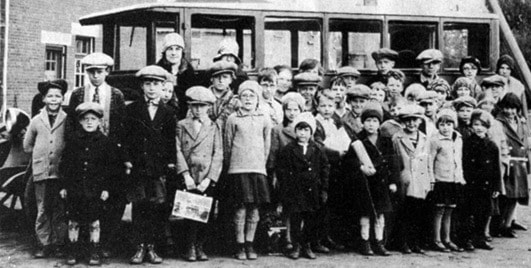Because in the early days we had to catch the Provincial Mental Hospital bus home immediately after school, we were not able to go to classmates’ houses, or to Brownies or Guides or Scouts, nor, when we got older, to the Club Cafe in Ponoka to hang out with our friends. In those days, children did not get bikes until they were around 12. Once we got bikes and our parents were satisfied that we could ride safely enough, we were sometimes allowed to ride to school, a journey which was more difficult coming home, since it was all uphill. I liked to get home in time to listen to the daily radio instalment of the Lone Ranger with its exciting theme music of the William Tell Overture, followed by Superman (introduction: Is it a bird? Is it a plane? No, it’s Suu-per-maaan.)
Safety did not seem to be a prime concern of the bureaucrats who authorized our school bus. It was a truck, with a large covered green wooden box on the back with a door which could only be opened from the outside, like a cattle truck. There were two small rectangles cut near the top to provide ventilation and light, but too high to see out of. Along each side and down the middle, there were backless wooden benches. Our driver’s name was John Blythe, and he had a patient named Sid as a helper. Sid rode in the cab with John and when we reached our destination, it was his task to open the door, pull down the little retractable step, and liberate us .The “bus” was stifling in the summer, freezing in the winter, and I loved it.
When I was in Grade 7, the green truck was retired and we got a blue and silver vehicle which resembled an armoured car, but did have real bus seats, upholstered in brown vinyl, which faced the front. Two years later, we got a real yellow school bus.
For our mothers, grocery shopping was simple. Two or three times a week, they would phone in their orders to one of the grocery stores downtown, and their groceries would be duly delivered to their kitchens before supper time, with the bill added to their running tab, which were to be paid at the end of each month. There was no charge for these services and it wasn’t unusual to find a chocolate bar or a package of lifesavers thrown in as a treat for the children.
The ice man delivered ice twice a week to the cottages in a horse drawn wagon. He would carry the ice right into the house with huge tongs, and place it in the ice box for the housewives. Small children would run after the ice wagon on hot days and pester the ice man for small chunks of ice to suck on.
There were other delivery people in our daily lives. Mr. Russell, our milkman, brought our milk in glass bottles every morning in another wagon pulled by a gentle old horse named Dynamite, a misnomer if there ever was one.
Remember the curling rink?
In the harsh prairie winters, the hub of social life on the hospital grounds was the curling rink. Everyone’s father, and many of the mothers curled in the hospital league, and games were scheduled every night, at 6:30 and 8:15.There were two lanes in the rink, and behind the glass window was a viewing area, heated by a wood burning stove. There was also a small food concession where coffee, pop and hot chocolate were sold. Occasionally someone would donate cookies or squares to be sold as well. My mother contributed homemade doughnuts; light, cake-like, and rolled in white sugar.
Next door to the curling rink were two crude outdoor skating rinks; a small one for the little kids and a larger one where the junior high girls worked on their spirals and bunny hops and tried to stay out of the way of the boys racing around practicing their slapshots. There was a shack by the skating rinks where we could huddle around the stove and try to thaw out our tingling feet, but it was much more fun to go next door to the curling rink, where we could watch our dads curl, and maybe get someone to buy us a treat. Later in our youthful and mostly joyful adventures of growing up on the grounds they added lights to the skating rink and offered curling lessons on Saturday mornings for the kids.
